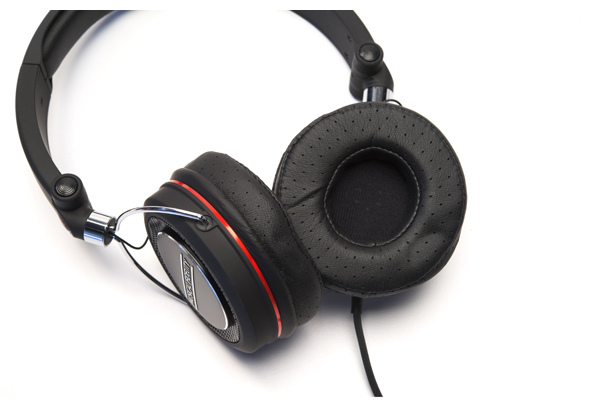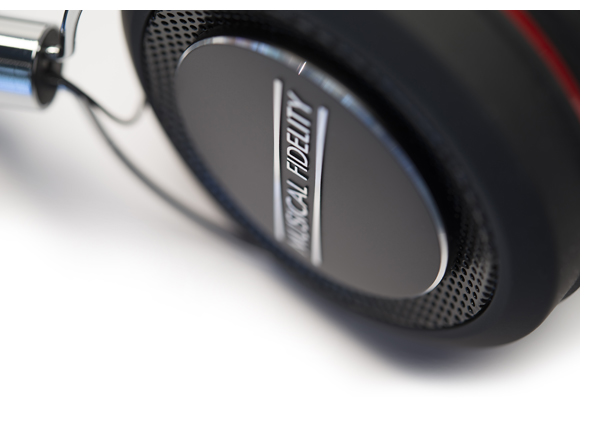Musical Fidelity MF-100 Headphones
 During my recent trip to the Sterling Sound mastering studio in New York City, where I visited with senior mastering engineer Greg Calbi, I had the rare privileged of listening to the new Beatles’ Yesterday and Today from Calbi’s chair. An uncompressed version of “Doctor Robert” comes through the MF-100 phones via my iPod Classic rather crisply.
During my recent trip to the Sterling Sound mastering studio in New York City, where I visited with senior mastering engineer Greg Calbi, I had the rare privileged of listening to the new Beatles’ Yesterday and Today from Calbi’s chair. An uncompressed version of “Doctor Robert” comes through the MF-100 phones via my iPod Classic rather crisply.
This $199 pair of phones does a cracking job at capturing the essence of the music. As I track through some of the tunes on the U.S. Beatles albums that were just released, the MF-100s become even more endearing. I forget that I’m sitting in terminal 2 at LaGuardia airport, as I become lost in that happy, comfy space in between my ears.
I stay locked into my own Beatlemania, with Sgt. Pepper’s next on the list, and all the trippy psychedelia contained within this classic is lovely when played through the MF-100s. There’s plenty of bass rumble in the intro of the title track, with a soundscape that floats well beyond the left and right ear boundaries. The ping-pong stereo effect reminds me of the conversation that Calbi and I just had about why we like the stereo mix of this record after all.
Initial listening in the TONEAudio studio reveals a slight sound difference between the Alcantara ear pads and the leather set (both of which are provided with the phones), such that I prefer the former. Changing the pads requires a modicum of dexterity, so I suggest picking your favorites and sticking with them. Only those with surgeon’s hands should attempt performing this task in an airport lounge, but kudos to Musical Fidelity for offering a choice, especially at this price point.
While we’re talking price, it’s well worth mentioning that the MF-100s have a build quality above and beyond what you’d expect from headphones in this range—from the ear pads and sleek frames to the internal workings and sonic reproduction. For those who care, the packaging is equally snappy. Though some might argue that the packaging is a trifle, my experience has always been that careful attention to all the details, no matter how minimal, is usually backed up by care in design and build throughout. The MF-100s are no exception. The look, feel, and sound are exquisite, especially for a $199 pair of phones.
The MF-100 is My BFF
By the time I touch back down in Portlandia, I’ve listened to six solid hours of familiar tracks via a 160-gigabyte iPod Classic, full of uncompressed titles ranging from the Rolling Stones to Justin Timberlake. With the iPod as the source, the MF-100s offer a healthy upgrade over the stock ear buds and they have a compact enough form factor that they are easy to travel with. The MF-100s look like open-back headphones, but they are not—a fact that Musical Fidelity designer Antony Michaelson confirms when we discuss his latest creation. The MF-100s continue his ongoing design philosophy of offering maximum performance while keeping costs in line. Every one of my headphone-crazed friends peg the MSRP of the MF-100s to be about $100 more than the actual price.
A few online forums have made note that the MF-100 sound slightly bright in overall tonality. These phones do have more than enough resolution to reveal the differences not only in source material but also in the nuances between sound sources. Admittedly, after six straight hours with only an iPod to drive them, I was feeling a bit of user fatigue starting to creep in, but switching to the ALO Audio PanAm DAC/amplifier (adding a few vacuum tubes to the mix) makes for a great upgrade in the overall sound quality, particularly in the high-frequency spectrum.
Keep in mind that the 64-ohm impedance of the MF-100s makes them a breeze to drive with whatever source you have at your disposal—they are more than good enough to warrant an amplifier upgrade. And it doesn’t have to have valves: The equally affordable AudioQuest DragonFly 1.2 DAC ($149) is a lovely step up that easily takes the MF-100s to another level sonically, making for a great portable hi-fi setup that won’t require your entire tax refund check.
The MF-100s benefit from about 50 hours of break-in before the drivers really stabilize sonically, eliminating the last bit of glare out of the box. Fortunately, these phones suffer less of this effect than a number of others we’ve sampled, so the delta from good sound to great sound is short.

Further Listening
Once the MF-100s are broken in and my ears recalibrate to their sound, I pull out the big guns, including the Taurus headphone amplifier from AURALiC, ALO Audio’s Studio Six, and the latest signature amplifier from Coffman Labs. The MF-100s are indeed resolving enough to discern the nuances between these top-shelf headphone amplifiers, which offer a glimpse at the ultimate performance envelope of the MF-100s. But much like putting a $5,000 phono cartridge on a $500 turntable, this is indeed overkill for the $199 MF-100s.
However, the MF-100s are ideal headphones for the music lover on a tight budget, and if great sound and build quality weren’t enough, the signal cord of the MF-100 features a button that syncs to your mobile device. For iPhone/Pod/Pad users, this allows you to access Siri—a nice touch for the jet-setter.
It’s safe to say that Musical Fidelity’s first attempt at a closed-back, over-ear headphone is a massive success—enough that we happily award it one of our Exceptional Value Awards for 2014 and purchase the review sample for our permanent headphone collection. We’ll be curious to see what comes out of the mind of Michaelson when he decides to give a $500 pair of phones a go.
– Jeff Dorgay


